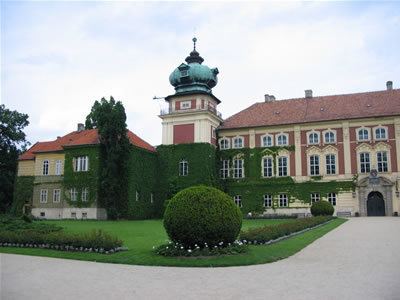Gmina Łańcut (urban gmina) Postal code 37–100 Area 19.43 km² | County Łańcut County Time zone CET (UTC+1) Car plates RLA Population 18,067 (2006) Local time Sunday 3:30 PM | |
 | ||
Weather 24°C, Wind SW at 19 km/h, 25% Humidity Points of interest Łańcut Castle, Maneż ‑ Kasy Muzeum, Storczykarnia, Zamek Lubomirskich i Potockich, Łańcut Synagogue | ||
Łańcut ( [ˈwaɲt͡sut]; German: Landshut, Yiddish: לאַנצוט-Lantzut), is a town in south-eastern Poland, with 18,004 inhabitants, as of 2 June 2009. Situated in the Subcarpathian Voivodeship (since 1999), it is the capital of Łańcut County.
Contents
Map of Lancut, Poland
History
Archeological investigations carried out in the region of Łańcut confirm the existence of human settlements from about 4000 years B.C.
The first owner of the town was Otton (z Pilczy) Pilecki, who was given the Łańcut estate by the Polish king, Casimir III the Great, in 1349, as a reward for his service. At the same time, the king also granted Łańcut its city rights according to Magdeburg law. In 1381 Łańcut was officially named a ‘town’ for the first time, by Otton Pilecki, in the foundation charter of the town. Łańcut remained under the ownership of the Pilecki family up to 1586.
The city was then owned consecutively by aristocratic Polish families of Stadnicki, Lubomirski, and Potocki. Łańcut was purchased by Stanisław Lubomirski in 1629, at which time he secured the services of architect Matteo (Polish: ‘Maciej’) Trapola and the stuccoist Giovanni Battista Falconi, in order to build a fortified residence in the town, Łańcut Castle, completed in 1641 and reconstructed many times since. Jerzy Sebastian Lubomirski, fearing attack from the Swedes, further strengthened the fortifications. To perform these works he employed Tylman van Gameren, a Dutchman and one of the most prominent foreign architects to ever work in Poland.
The castle is situated in the centre of the town and constructed in the style of a grand aristocratic palace-residence. It was last owned until 1944 by the Potocki family, and made infamous in late 16th century during the times of Stanisław Stadnicki, who was known as 'the Devil of Łańcut' (Polish: diabeł łańcucki) for his violent behaviour. After 1775 the palace was owned by Izabella Lubomirska, who extended it and had the interiors remodelled. The palace is currently a museum particularly well known for its large collection of historic carriages. Since 1961, a well-known classical music festival is held there annually.
In 1772, after Poland's First Partition, Łańcut became part of the Habsburg Monarchy where it remained until 1918 when it became part of independent Poland.
At the end of the 18th century, Duchess Izabela Lubomirska established a distillery on the vast estate of the Lubomirski family in Łańcut. Count Alfred Wojciech Potocki, a grandson and heir of the Duchess, started to run the Łańcut and Lwów Lubomirski estates in 1823. He modernised the management of these properties. The distillery has changed ownership several times and now exists under the name of Polmos Łańcut. It is well known for producing flavoured and sweetened vodkas.
The last owner of Łańcut, Alfred Antoni Potocki, (14 June 1886 – 30 March 1958), was one of the richest men in prewar Poland, accumulating a fantastic collection of art during his tenancy. Shortly before the arrival of the Red Army in 1944, he loaded 11 railway carriages of a specially chartered train to Vienna, with his most valuable possessions (about 700 boxes of movable property) and fled to Liechtenstein. Most of these valuables were gradually sold off to finance a lavish lifestyle
Prior to World War II, Łańcut had a thriving Jewish community constituting about one-third of the city population. Local Jewish cemeteries are the resting place of the famous Rabbi Zvi Naftali Horowitz, the Grand Rabbi of Ropshitz (Ropczyce) and Rabbi Ahron Moshe Leifer, the Grand Rabbi of Żołynia. Every year, followers of the Hasidic Judaism come to pray at their graves. On August 4, 1942 (21 Av), a German SS extermination unit took some 2,750 Jews of Łańcut to the Falkinia Forest where they were herded near a mass grave and executed by machine gun.
The Music Festival in Łańcut has been an annual event since 1961. The Festival is a series of modern and classical music concerts performed by distinguished European soloists, ensembles and choirs.
Main sights
Transport
Łańcut is located on the main West-East European E40 Highway, which goes from Calais in France via Belgium, across Germany, Poland, Ukraine and on to Russia and Kazakhstan. Circa 2008, the A4 highway was announced. Despite it was meant to be done before Euro 2012, it was not finished by July 2014. This caused a large worker protest, after which the contract was broken. However, now the A4 north of Łańcut is expected to be completed sometime in 2016 Other Polish cities located by the E40 highway are Wrocław, Opole, Katowice, Kraków, Tarnów, Rzeszów and Przemyśl.
The nearest airport is Rzeszów-Jasionka Airport located in the village of Jasionka, north of Rzeszów. It is about 18 kilometres (11 miles) north-west of Łańcut on the A881 and takes about 25–30 minutes by car. Scheduled passenger services include flights to: Warsaw (WAW), Dublin, London (Stansted), Bristol, UK, Birmingham, UK, New York City (JFK Airport, and Newark Liberty International Airport).
Łańcut has a railway station, located at Kolejowa Street 1. It is on the main line, Kraków Main station — Medyka. The line then continues on to Ukraine.
The bus station is located at the crossroads of Kościuszko Street and Sikorski Street.
Twin towns — sister cities
Łańcut is twinned with:
